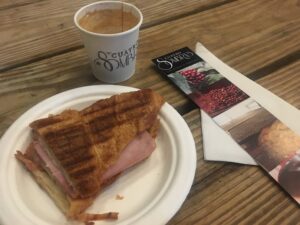
I think this day, our tenth day in Puerto Rico, was probably my favorite day of all the days we spent there. While I do love visiting old cemeteries, grand castles, educational museums, expansive parks, and so on and so on, there’s nothing that quite satisfies my desire to experience and learn about the local culture than through a food tour. And on this day we treated ourselves to not one food tour but two!
The only regret I have about the food tours is that I wish we would’ve done them sooner in our stay rather than later, as you’ll always pick up little tidbits of information that might inspire you to add something to your list of things to do. And the Flavors Food Tours definitely did not disappoint. We signed up for the Classic Old San Juan Food Tour and the Rum Runners Craft Cocktail Tour, and both were quite delightful.
Our tour guide for the food tour was Ricardo, un hombre guapo y inteligente. Él estudia historia en una universidad en San Juan se llama Centro de Estudios Avanzados de Puerto Rico y El Caribe. (Huh! Apart from the name of the school, I was able type all that out without using a dictionary!) It was clear that not only was Ricardo distractingly handsome as he studied for a masters degree in history (“What have I gotten myself into?” he bantered), but he also had a genuine passion for the people of Puerto Rico, especially the history of their food!
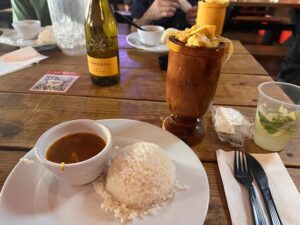
Our first stop on the tour was to Cuatro Sombras, a coffee and sandwich cafe. Sombras seems to translate to several things, but the likeliest would probably be shades, as their website indicates their beans are grown in the shade to “allow the beans to mature more slowly and have more contact with the sugars.” We got to enjoy a cup of espresso prepared cortado style (half espresso, half milk) with a sinfully buttery croissant (but a flatter style of croissant) with ham, provolone, and guava butter. The espresso was so absolutely delicious, bold and vibrant, the milk tempering the acidity of the espresso in a delicate harmony of flavors, while the ham, provolone, and guava butter complimented each other in an uncomplicated choreography of the passions, the melted provolone coaxing the saltiness of the ham to embrace the sweetness of the guava in a symphony of delightful sensations. As we enjoyed the espresso and the croissant, Ricardo provided us with a brief history of coffee, how—like ales—it was safer to drink than regular water because it was made using boiled water, how it was exported from the Middle East, and so on.
Our next stop was to El Patio de Sam, and unfortunately this place was probably my least favorite stop. While the ambiance of the restaurant was inviting—colorful tables with blue and yellow tiles, bold yellow walls adorned with colorful art, an elegant wooden bar with a mesmerizing selection of spirits—the food left much to be desired, as if apologizing for its very existence. We were served carne frita con tostones—a Puerto Rican staple—but the meat was quite dry and tough and perhaps a bit too salty, and I don’t even remember eating the tostones. However, while my mouth was treated to sensations best left untold, my mind was treated to Ricardo’s stories best oft repeated: how pork and plantains aren’t native to Puerto Rico but have become such mainstays of the local cuisine and how fried meats are a specialty during Christmastime as frivoleters jaunt from place to place enjoying endless varieties of carnes fritas. Let’s just hope that during Christmastime that other establishments prepare the plato in a better fashion than El Patio de Sam.
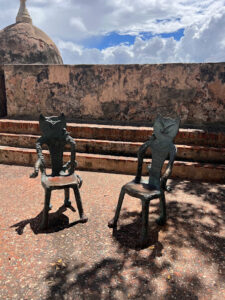
We next made our way past Catedral Basilica Menor de San Juan Bautista (which we had visited on día cinco, and which I still think you should go visit) and the nearby Hotel El Convento (an old nunnery turned four-star hotel), to a small square called Bastión de las Palmas (once a major defensive section of the Viejo San Juan city walls) outside of a little shop called Señor Paleta, to enjoy a frozen treat on a day just hot enough that you might find yourself perspiring, even with the ocean breeze. Paleta translates to a few words (including blade and trowel), but in the context of food it refers to a popsicle (which has a trowel-like shape, come to think of it). We got to enjoy paletas parchas (passion fruit popsicles), that were welcomingly and slightly mouth-puckeringly citrusy, activating salivary glands to overdrive, as the flavors consumed every sensation imaginable. It was the perfect food to have midway through our tour, especially as we were right by the historic Bastión de las Palmas that allowed us enchanting views of San Juan Harbor.
Ricardo made sure to point out La Casa Estrecha (San Juan’s narrowest house, painted brightly in yellow, standing two stories tall but only five feet wide, squished between wider, taller buildings on either side) and Polo Norte Fabrica de Soda (“North Pole Soda Factory,” a characteristically colorful building of yellows and blues, a soft drink factory established in 1902 by Angel Rivero Méndez) before we moved on to Vaca Brava, which probably translates to Brave Cow or Spicy Beef, if my reading of Collins Dictionary is to be believed. Perhaps it’s actually a dark pun on the fact that a cow must be brave in order to be turned into spicy beef, the poor dears.
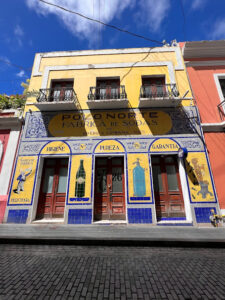
Before we enjoyed the main course at Vaca Brava, we got to make our own mojitos. The key to making an authentic Puerto Rican mojito is to place the mint leaves in the palm of one hand and then strike both hands together as if clapping loudly only one time to help release the oils of the plant. Mint began to permeate the air as we mixed the rum, lime, soda water, and simple syrup into a classically delightful concoction. Soon, a hefty serving of chicken mofongo arrived at our tables, the mashed plantains and chicken arriving in a tall wooden cup with the usual sides of frijoles y arroz. And it was so, so tasty and so, so filling I only just barely managed to finish my plate. Ricardo regaled us of the history of mofongo and the origin or the word, which all helped to verify my own research on the dish when I wrote about este plato delicioso for día tres.
It seemed much too soon as we began heading to our last stop, La Picadera, which seems to translate to snacks. The restaurant started in 2014 with a selection of fried finger foods and coffee, but eventually the menu grew to include more sophisticated fare unworthy of the title snacks, as we got to consume the most enchantingly delicious flan I ever got to enjoy. It was unapologetically light and creamy and the perfect level of sweetness, a caramel glaze more consistent with honey on top of a splendidly shaped circle of chilled custard prepared to superior excellence, a flan to which all other flans will now be compared for the rest of my life.
Our first tour concluded, we had a bit of time to pass before our Rum Runners tour began, so we made our way to Scryer Rum and Barrelhouse, where we continued to indulge in our appreciation for well-crafted rum that can be used in drinks generally meant for fine whiskeys. Skryer had a version of that New Orleans classic, the sazerac, prepared with rum instead of rye, and I might’ve had a difficult time telling the difference between the genuine article and this Puerto Rican rendition. With still more time to pass, I had a second drink, a so-called classy lassy, a slightly sweeter—but not too sweet—concoction of rum, lemon juice, honey, and port.
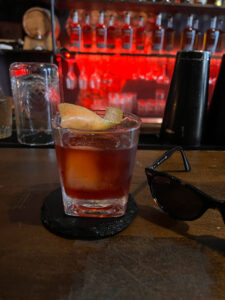
It was during our visit to Scryer that we got to hear more about the locals’ perspectives on Puerto Rican statehood. I had written about this a little bit on día seis when we visited the coffee plantation museum in Jayuya, and our conversation with the bartender did little to help me decide on the best solution, as independence, statehood, and commonwealth each have their benefits but also each are fraught with complications. Our bartender was unapologetically anti-statehood, explaining that his generation (he couldn’t have been much older than I am), tends to be anti-statehood because the pro-statehood party that they grew up knowing was rife with corruption, which has colored their perception of the issue. He also explained that one day he will have to leave the island—something he’d prefer not to do—as lucrative career opportunities on the island are few and far between, remarking that he’s seen many others leave the island for the states and who have yet to return.
After listening to his story, I left feeling that I still didn’t know the answer, but that I can nonetheless be persuaded for any of the three options for Puerto Rico’s future. It will take people smarter than me to figure this all out, however, but sadly the wheels of government can turn so slowly, and I don’t foresee a change in the status quo any time soon.
We quickly were off to our next tour, the Rum Runners Craft Cocktail Tour, this time with young Yoli—standing barely above five feet—who was our guide imparting her own knowledge as we made our way through three bars to enjoy, naturally, more rum. Our first stop was, coincidentally, Scryer, which we had just frequented. But this time, we got to go in the back of the bar to learn about the distillation process from the owner, Derek Schwarz, a precocious young lad who studied Scotch whiskey distillation processes in, as you would expect, Scotland, and who brought what he learned to Puerto Rico with dreams to craft not his own Scotch but his own rum with his business partner, Garrett Robinson. Skryer, as it happens, is Scottish for one who predicts the future, a dreamer, you might say.
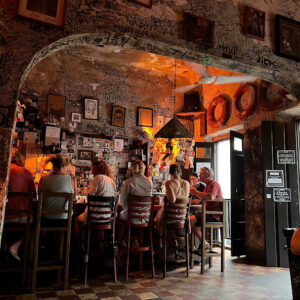
We got to try three varieties of their rum, poured neat, directly from the barrels: one aged in an old port barrel, another in a sherry, and a third in a barrel whose details are escaping me, and they were all potently strong and hypnotically profound in their layers of aromas and flavors. After the two cocktails earlier and the three pours during the tour, I sensed a giddy delight within me begin to reveal itself, as you can no doubt imagine.
Our next stop was El Batay. While Skryer was a classy place with a tall, smart, wooden bar with walls dimly lit in elegant red lights, El Batay was a kind of bombed out punk dive bar frequented by hipsters, dirty red and white square tiles on the floor, walls and tables purposely marred with messy scribbles and chaotic graffiti, as if a Jackson Pollock painting was created with the names and words of the generations who visited this place. Indeed, the Rolling Stones are known to frequent El Batay, and one of their tunes happened to have been playing on the jukebox when we were there.
At El Batay, instead of sipping rum, we got to enjoy a mixed cocktail called the vaccine, a mixture of rum, grapefruit, and lime. And I’m so sorry, but I’m forgetting much of the details beyond that as I was so entranced by the unashamedly grimy ambiance of El Batay that I could’ve been served some sort of magical cocktail mixed with the most expensive rum and my eyes still couldn’t have been distracted by the beguilingly entrancing scratchings and scrawlings that embellished the walls in a schizophrenic deluge of bold, chaotic, disordered colors.
Our third and final stop was La Cubanita, a slightly less divey establishment compared to El Batay, but still divey nonetheless—tall ceilings adorned with thick wooden beams, white walls cracking with age and exposing timeless brick underneath, a young mustached bartender wearing a vintage patterned shirt who wouldn’t look out of place in a Terry Gilliam film featuring Benicio Del Toro. La Cubanita is a part of a series of bars—one of them called La Factoría—that is connected by secret passageways. La Cubanita itself used to be a convenience store and is now a world heritage site turned bar, meaning that any repairs to the building need to be completed in the style and practices of when the building was built, something that is prohibitively expensive. And so La Cubanita remains in a state of disrepair (this isn’t meant pejoratively) that lends itself to its uniquely worn charms, rough around the edges.
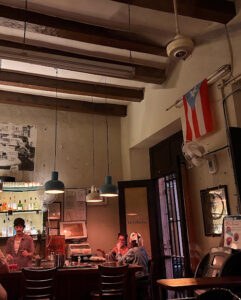
Our final drink for the night was a concoction of ginger, hibiscus, lime, and rum and named after tourist Mike Billions who wanted the bartender to make him something gingery. (It was, indeed, a gingery drink.) It wasn’t before long that the Rum Runners tour was complete, and Amy, Aaron, and I decided to have another round of drinks at La Cubanita. I got a drink called Fuego 23, a mixture of mezcal, vermouth, and soursop, a fruit with flavors like strawberry, apple and sour citrus.
We wanted to visit a restaurant called Barrachina, a tip from Ricardo earlier who explained they have the best frozen piña coladas. Sadly, the night was waning fast and there were no more reservations available for the evening, so instead we went to a restaurant called Bacaro, un restaurante italiano. We enjoyed a bruschetta platter, more mezcal, various platos de pasta, and a cheesecake flan. Bacaro provided a great way to find out how Italian food is prepared in Puerto Rico (“Pretty good!” I’d say), and it was a fine way to end a day that celebrated food and drink.
The night felt mildly sultry, moisture heavy in the air, but the ocean breeze made everything feel comfortable and pleasant. On our way back to the car and then onwards back to Jayuya, we took in some final sights of Puerto Rico lit up a night, stopping by Plaza de Armas, an elegant square with an exquisite fountain, pink and purple lights shining off the nearby San Juan City Hall causing the water to glow a calming violet. What a delight it was to become familiar with such an enchanting city through its people, its food, and its drink. Absolutely an impeccably perfect way to spend a day!
We still felt we made the correct decision, canceling our trip to El Yunque National Forest, so we could have another day to explore San Juan, except this time outside of the historic hub of Veijo San Juan and onwards to the more artistic neighborhood, Santurce…
Spanish lesson for the day:
- DuoLingo will teach you that pastel (plural: pasteles) means cake. But Ricardo told us that in Puerto Rico it means something else entirely, a beloved Christmastime treat: “Christmas pastel consists of some combination of mashed viandas (root vegetables and plantains), a mixture of yautía (malanga) and guineo verde (green banana), olives, garbanzo beans, manteca de achiote (annatto-infused lard), and minced pork, all wrapped in banana leaves and parchment paper. The whole package is boiled in salty water for an hour.”
- If you want to pay your bill in cash, you can say, “Quiero pagar en efectivo,” or, “I want to pay in cash.” If you want to pay in credit you can say, “Quiero pagar con tarjeta de crédito.”
- If you’ve come to a restaurant and only want to enjoy some drinks and no food, you can say, “Solo queremos bebidas, por favor,” or, “We only want drinks, please.”
- If you want to say you’re familiar with a city or country or person, you can use the verb conocer. “Conozco San Juan,” means, “I’m familiar with San Juan,” while “Conocemos Puerto Rico,” means, “We’re familiar with Puerto Rico.” If you are talking about people, you’ll add an extra word: “Conozco a tu amigo,” which means, “I’m familiar with your friend,” or, “I know your friend.”
Travel tips, day ten:
- If you make it to La Picadera, as you enter make sure to watch out for these giant, colorful masks representing key historical figures, generally used for the San Sebastián Festival, one of Puerto Rico’s largest street festivals celebrating the saint.
- Be on the lookout for Banco Popular, a bank chain in Puerto Rico, whose branch in Viejo San Juan is a tall, gorgeous, art deco building—the style having since been banned in order to maintain the more historical architecture.
- On our food tour, Ricardo told us of how San Juan—like Minneapolis—used to have an impressive streetcar system and how he would love to see it return and lamented the fact that it was dismantled in the first place. It was just another reminder that the easiest way to get around town is by car, as even the existing bus system is woefully inadequate.
- While Puerto Rico has made some progress on restoring and repairing the damage from Hurricane Maria, Ricardo told us of how San Juan seemed like an episode of The Walking Dead during the weeks and months following the catastrophe. You’ll notice that the more touristy parts of Puerto Rico have been more quickly re-built, but there are many areas in the more rural parts where, sadly, houses are still abandoned and in disrepair.
*These photos by Amy Danielson. All others by me.

My translation – We want a lot of food and drink please. A vacation in Puerto Rico day ten. Love Mama
You got it! ¡Tu aprendes español muy bien!
I haven’t translated the other Spanish words in your entry, but I will to keep this old brain functional!